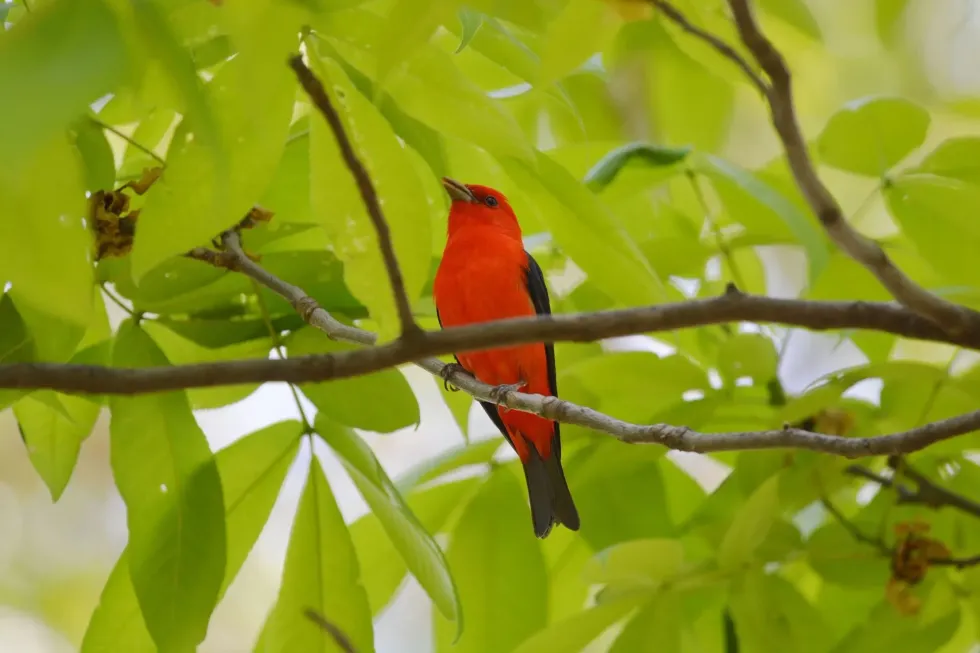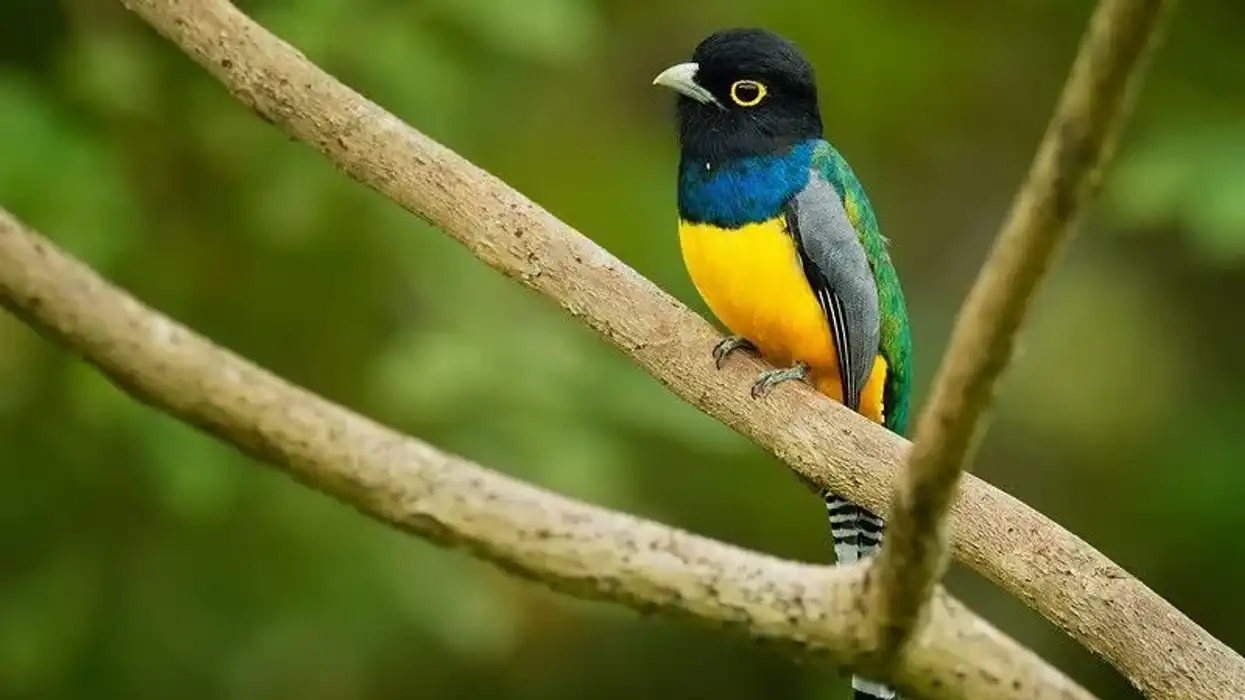Among the smallest of the different species of the Piranga genus, the scarlet tanager (Piranga olivacea) is a songbird with a brilliant red plumage, black wings, and tail. Breeding male scarlet tanagers are among the most visually mesmerizing North American birds.
A female scarlet tanager is olive-green with dark wings and a tail. Though they are fairly common birds, they are rarely spotted as they nest and forage atop forest canopies.
Scarlet tanagers are long distant migrants, starting their journey from their breeding range in North America. They fly towards the foothills of the Andes in South America for the winter. One of the threats that scarlet tanagers face is habitat loss due to forest fragmentation caused by humans.
Let’s find out more about this songbird, often described as a ‘robin with a cold’. If you like this article, why not check out more facts on the keel-billed toucan and tawny frogmouth.
Scarlet Tanager Interesting Facts
What type of animal is a scarlet tanager?
Until recently, scarlet tanagers were placed in the Tanager family. Now, they are classified as part of the Cardinal family (Cardinalidae). They are North American songbirds, often called a ‘robin with a cold’.
What class of animal does a scarlet tanager belong to?
The scarlet tanager (Piranga Olivacea) belongs to the Aves class.
How many scarlet tanagers are there in the world?
The exact number of scarlet tanagers is undetermined. However, based on the findings of the American Bird Conservancy dated 2016, the population was estimated to be upwards of 2.7 million, making their conservation status that of Least Concern.
Where does a scarlet tanager live?
Scarlet tanagers are found mainly in the range of eastern North America which serves as their breeding ground. During the winter, they migrate towards northern and western South America around the Andean foothills.
What is a scarlet tanager’s habitat?
These North American birds prefer temperate, subtropical, or tropical forests. The scarlet tanager is a challenging bird to find in trees as its habitat range is usually situated high up in trees in forests.
They are also known to be found in the range of mixed deciduous forests, heavily wooded suburban areas, and mature deciduous trees.
There have been sightings of these birds in a couple of woodlots in and around New York too. The scarlet tanager’s habitat during migration to the wintering grounds is not well known, but they can be found in evergreen forests.
Who do scarlet tanagers live with?
Northern scarlet tanagers live in small flocks but not close to each other as they are territorial birds. They are monogamous each season when a male and female adult pair nest together.
During migration in winter, they travel in small flocks and join flanks with other birds like the cerulean warbler and wood thrush as they fly mostly at night.
In the wintering grounds, scarlet tanagers take part in a mixed-species forage which includes woodcreepers, tropical tanagers, and flame-faced tanager among others. They fly towards the foothills of the Andes in South America for the winter.
How long does a scarlet tanager live?
The average lifespan of this Northern ‘robin with a cold’ is about 121 months or around 10 years in the forest. They fly towards the foothills of the Andes in South America for the winter.
How do they reproduce?
During the breeding season, adult males usually arrive first at the breeding grounds to select the ideal tree. Each adult male sings a song frequently from his chosen spot to warn the other males away.
The entire process of courtship, nest laying, and eggs hatching in the breeding ground takes less than two weeks, post the arrival of the females.
The frequent bursts of sound and song by a male scarlet tanager attracts the female. As part of the courtship, the male hops about on branches below a perched female. They extend their dark wings, neck, and tail to show off the brilliant coat of red with black wings to attract the female.
Within a week of mating, the female builds a nest. They are built on a horizontal branch, away from the main tree trunk at a height ranging anywhere between 13-246 ft (4-75 m) from the ground.
The number of eggs in a clutch range between three to five eggs, usually being four for hatching. The nest looks like a shallow cup made of twigs and weed.
What is their conservation status?
Their conservation status is of this species is Least Concern as the scarlet tanager population is stable, which means they are not rare.
Scarlet Tanager Fun Facts
What do scarlet tanagers look like?
Arguably one of the most beautiful and showy birds to grace the land, the mature male scarlet tanager, during the breeding season, has a lustrous red coat with black wings and tail. Female scarlet tanagers are dull, olive green, with darker wings and tail.
Their underparts are a yellow tinge. The immature and chick birds also have a similar yellow color.
Another interesting fact is that the mature male scarlet tanager molts after breeding. During the winter, the males' colors are unrecognizable as they almost resemble the females.
The only difference is that they retain the black of the wings and tail. As spring and summer approach, the male scarlet tanager loses the green and yellow color. He gets his luminous red color back for the next breeding season.

How cute are they?
At first glance, breeding male scarlet tanagers look majestic. Once you get past the striking beauty, you realize the slightly large heads and stout bodies make them look downright cute.
How do they communicate?
The sound or call made by this bird is a repetitive sing-song warble, similar to the robin, but with a burry quality. It is described as a ‘chip-burr’. The females’ sounds are shorter and softer.
Both male and female birds sing and call. They burst into song together while foraging and also when the female nests. Apart from these sounds, they also communicate using their colors and movements during courtship.
How big is a scarlet tanager?
Scarlet tanagers range from 6.2-6.6 in (16-17 cm) in length with a wingspan of 9.8-11.4 in (25-29 cm).
How fast can a scarlet tanager fly?
Flight speed is not yet recorded.
How much does a scarlet tanager weigh?
Their weight ranges from 0.8-1.3 oz (23-38 g) during the breeding season. During migration, they are thought to weigh between 1-1.3 oz (32-38 g).
What are the male and female names of the species?
The males and females of this species don't have separate names.
What would you call a baby scarlet tanager?
There is no separate name given to a baby scarlet tanager. They can be called fledglings or chicks.
What do they eat?
During the summer, they feed on insects like moths, caterpillars, bees, locusts, dragonflies, and beetles, termites. They are also known to consume spiders, snails, and millipedes. These dazzling birds of red with black wings consume a wide range of berries such as blackberries, strawberries, and mulberries when insect availability is low.
The exotic color of the scarlet tanager is also slightly disadvantageous as predators can easily spot them. While they are less exposed in the deep bowels of the forests, they face multiple threats from birds of prey like eastern screech owls, short-eared owls, and merlins. The eggs and nestling predators include snakes, chipmunks, grackles, blue jays, and American crows.
Are they dangerous?
Scarlet tanagers pose no threat to humans. In fact, they help us by consuming pesky insects.
Would they make a good pet?
For all the beauty and charm that scarlet tanagers possess, they don’t do well in a household setting. They are migratory and being insectivorous, they are ideally meant to be in the forest. However, if one wishes to keep them as pets, their housing requirements should be very similar to their natural habitat.
Did you know…
A fledgling scarlet tanager leaves the nest within 15 days of hatching. The male goes through a complex series of extra seasonal molts. It is only in the spring of his third year that he acquires the brilliant red plumage and breeding status.
They represent peace, joy, optimism, and spotting them is considered lucky.
Do scarlet tanagers eat oranges?
Bird enthusiasts in New York have spotted scarlet tanagers consuming orange slices. This could be because the bird has returned from a long migration journey and consumes some fruit before foraging for insects.
Where do scarlet tanagers migrate to?
These birds make their migratory journey twice a year. The scarlet tanager migrates from its deciduous forest habitat in eastern North America to north and western South America.
Here at Kidadl, we have carefully created lots of interesting family-friendly animal facts for everyone to discover! Learn more about some other birds from our common kingfisher facts and carrion crow facts pages.
You can even occupy yourself at home by coloring in one of our free printable Scarlet tanager coloring pages.










